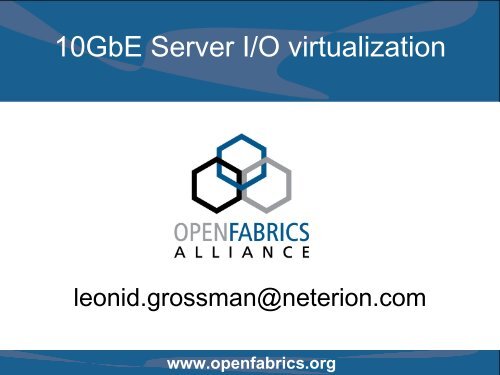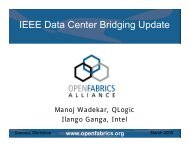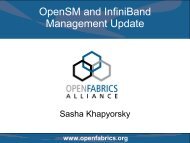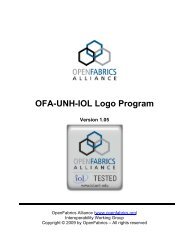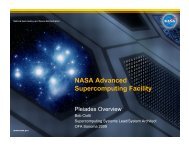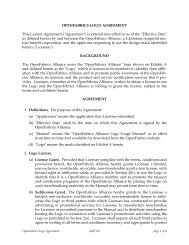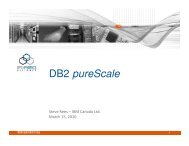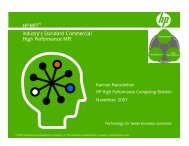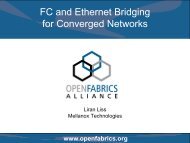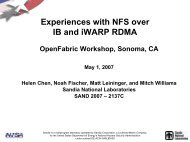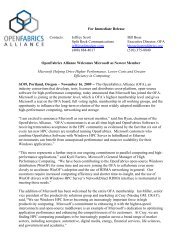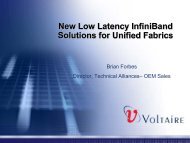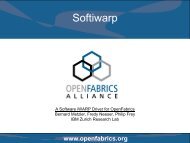10GbE Server I/O virtualization
10GbE Server I/O virtualization
10GbE Server I/O virtualization
Create successful ePaper yourself
Turn your PDF publications into a flip-book with our unique Google optimized e-Paper software.
<strong>10GbE</strong> <strong>Server</strong> I/O <strong>virtualization</strong><br />
leonid.grossman@neterion.com<br />
www.openfabrics.org
Agenda<br />
‣Introduction<br />
‣<strong>Server</strong> I/O <strong>virtualization</strong> trends and<br />
challenges<br />
‣<strong>10GbE</strong> market trends and challenges<br />
‣<strong>Server</strong> I/0 Virtualization and Sharing with SR<br />
and MR IOV <strong>10GbE</strong> NICs<br />
‣Direct PCI Function assignment to Guest<br />
Operating Systems<br />
‣Hypervisor assists in Virtual Ethernet Bridges<br />
www.openfabrics.org<br />
2
Neterion Introduction<br />
• Shipping 10Gb Ethernet adapters since 2003<br />
• 3rd Gen IOV silicon is shipping now<br />
• Designed for Virtual I/O and Shared I/O<br />
Datacenter solutions<br />
• Broad OS and hypervisor support<br />
Neterion<br />
E3100<br />
Neterion<br />
X3100 Series<br />
Neterion<br />
Xframe E<br />
Neterion<br />
Xframe II<br />
www.openfabrics.org<br />
Neterion<br />
Xframe<br />
3
<strong>Server</strong> I/O <strong>virtualization</strong> trends<br />
and challenges<br />
‣ <strong>Server</strong> <strong>virtualization</strong> is one of the most dominant trends in the datacenter.<br />
Virtualization and consolidation are driven by rising datacenter costs of power,<br />
real estate and management/support, as well as the multi-core cpu advances.<br />
In the next few years, most of server growth is expected to be related to<br />
<strong>virtualization</strong>.<br />
‣ The trend favors smaller number of bigger systems/clusters, as well as more<br />
sophisticated I/O adapters in fewer I/O slots.<br />
‣ I/O <strong>virtualization</strong> has been lagging cpu/memory <strong>virtualization</strong>, with most I/O<br />
intensive applications remaining on dedicated servers – to a significant degree,<br />
due to the lack of IOV solutions with adequate level of performance, isolation<br />
and service level guarantees. Such IOV solutions just started to get enabled by<br />
advances in hypervisors and arrival of IOV-compliant I/O hardware.<br />
‣ Virtualization is expected to make a profound impact on Datacenter I/O fabric,<br />
accelerating some I/O fabric trends and slowing down other trends.<br />
‣ At present, the trend may be less applicable to HPC – although the correlation<br />
between HPC and broader server market developments is likely to be<br />
significant.<br />
www.openfabrics.org<br />
4
<strong>10GbE</strong> market trends and challenges<br />
‣ <strong>10GbE</strong> adoption in volume servers remains slow relative to earlier Ethernet<br />
cycles, mainly due to technology cost/complexity and to the large number of<br />
related discontinuities (IOV, converged fabric, rise of multi-core systems).<br />
‣ <strong>10GbE</strong> market remains very fragmented, with large number of vendors playing<br />
in different segments and eying eventual “converged fabric” offerings.<br />
‣ 10G-BT and <strong>10GbE</strong> LOM remain a “moving target”, and are not likely to be<br />
broadly deployed until cost and power approach GbE levels (no time soon).<br />
‣ Attach rate for non-virtualized basic <strong>10GbE</strong> NICs and blade mezzanine cards<br />
remains low, due to the same power/cost constrains.<br />
‣ Virtual I/O and Shared I/O will likely be the first <strong>10GbE</strong> technology competitive<br />
with GbE; as such it may become the largest <strong>10GbE</strong> segment and to facilitate<br />
<strong>10GbE</strong> adoption in volume servers.<br />
‣ <strong>Server</strong> Virtualization and <strong>10GbE</strong> IOV are very complimentary industry<br />
developments, and have potential to increase each other’s adoption rate.<br />
‣ <strong>Server</strong> I/O <strong>virtualization</strong> is likely to accelerate some <strong>10GbE</strong> NIC features (SR<br />
IOV adoption, support for Virtual Ethernet Bridges and other hypervisor hw<br />
assists) and somewhat slow down or redefine other features (like iSCSI and<br />
RDMA offloads).<br />
www.openfabrics.org<br />
5
<strong>Server</strong> I/0 <strong>virtualization</strong> and sharing<br />
with SR IOV and MR IOV <strong>10GbE</strong> NICs<br />
‣ SR IOV and MR IOV specifications were released by PCI SIG last year.<br />
‣ SR-IOV compliant NICs are expected to arrive in early 2009 and deliver<br />
low-cost support for multiple PCI Functions.<br />
• From the system view, each function is an independent PCI device (SR IOV<br />
OS support will “translate” SR IOV VFs into full PCI functions).<br />
• SR IOV OS support is “work in progress” in Xen, and is expected to happen<br />
in other hypervisors.<br />
• The functions share <strong>10GbE</strong> port(s) and PCI bus; degree of sharing for other<br />
NIC resources may vary from vendor to vendor.<br />
• X3100 hardware is available (including IOV PDK), Linux GPL kernel driver<br />
and IOV-related Xen patches are submitted.<br />
‣ MR IOV capable NICs are expected to facilitate high scalability, low<br />
cost/power shared I/O solutions for rack servers and blades. Among<br />
other benefits, server administrators will get ability to abstract/preconfigure<br />
I/O profiles for both virtualized and non-virtualized servers.<br />
www.openfabrics.org<br />
6
Direct PCI Function assignment to Guest<br />
Operating Systems<br />
‣ Incumbent solutions (emulation and para-<strong>virtualization</strong>) make progress but still<br />
do not meet needs of I/O intensive applications, due to high overhead of I/O<br />
<strong>virtualization</strong> and limited hypervisor ability to provide I/O service level<br />
guarantees.<br />
‣ Running benchmarks at <strong>10GbE</strong> line rate in a guest is possible with multi-queue<br />
solutions – but at the expense of additional driver complexity and %cpu<br />
overhead.<br />
‣ Direct PCI Function assignment achieves I/O performance similar to native<br />
Guest performance on the same system – while preserving <strong>virtualization</strong><br />
benefits like migration, and leaving control over privileged operations with<br />
hypervisors.<br />
‣ Direct hardware access can be further improved by using “native” driver in a<br />
guest OS – same driver is used regardless of which Hypervisor is deployed (or<br />
none). This model offers a number of certification and distribution benefits, and<br />
supports the same rich native stack feature set in either virtual or native worlds.<br />
This model requires SR IOV VF and PF to support the same resources.<br />
‣ Direct PCI Function assignment can enable <strong>virtualization</strong> of I/O intensive<br />
applications, and increase market penetration for both <strong>10GbE</strong> and for<br />
hypervisors.<br />
www.openfabrics.org<br />
7
Advanced IOV features supported by<br />
IOV <strong>10GbE</strong> NICs like X3100<br />
Virtualized <strong>Server</strong><br />
Virtualized<br />
network<br />
App ‘n’<br />
App ‘n’<br />
OSApp ‘n’<br />
OS<br />
Network<br />
Stack OS<br />
Network<br />
Virtual Stack<br />
Network<br />
Driver<br />
Virtual Stack<br />
Driver<br />
Virtual<br />
Virtual<br />
Driver<br />
Machine Virtual<br />
Machine Virtual<br />
Machine<br />
Software<br />
VSwitch<br />
Neterion<br />
X3110<br />
Hypervisor<br />
(SR IOV<br />
support<br />
is optional)<br />
X3100 Driver<br />
…<br />
0 1 2 3 . . . 16<br />
NIC EVB<br />
Passthru<br />
network<br />
App ‘n’<br />
App ‘n’<br />
OSApp ‘n’<br />
Native OS<br />
Network<br />
Native OS<br />
Stack<br />
Network<br />
Neterion Stack<br />
DriverNetwork<br />
Neterion Stack<br />
Driver<br />
Virtual<br />
X3100<br />
Driver<br />
Machine Virtual<br />
Machine Virtual<br />
Machine<br />
In addition to SR IOV and MR IOV support, Neterion X3100<br />
series includes some additional IOV advanced features:<br />
‣ HW translation of SR IOV to legacy multifunction – direct<br />
hw access from a Guest is not gated by SR IOV support<br />
in BIOS/OS. X3100 functions work the same way in both<br />
IOV-aware and legacy environments.<br />
‣ PF level support for SR IOV functions. This provides for<br />
better protection and isolation that an alternative queue<br />
pair based approach. Also,<br />
no split netfront/netback driver model is required; native<br />
Linux or Windows drivers run in guests and see the same<br />
set of resources.<br />
This model allows leveraging work done for the native<br />
OS:<br />
• Driver certification and distribution.<br />
• Native networking features like Multi-Queue support,<br />
Bonding, etc.<br />
‣ Embedded X3100 <strong>10GbE</strong> Virtual Ethernet Bridge (VEB)<br />
allows a hypervisor to control traditional privileged NIC<br />
operations on PCI Functions assigned to guests.<br />
www.openfabrics.org<br />
8
Hypervisor hw assists<br />
with Virtual Ethernet Bridges<br />
‣ VEB is controlled by a privileged domain like a hypervisor or a shared<br />
I/O chassis manager. VEB typically supports number of IOV-related<br />
capabilities:<br />
• Direct incoming frames to the correct PCI Function.<br />
• Support forwarding networking traffic between PCI Functions; Guests can<br />
utilize PCI bandwidth instead of <strong>10GbE</strong> bandwidth for inter-VM traffic.<br />
• Allow privileged domain to control traditional privileged NIC operations on<br />
PCI Functions assigned to guests. Such control is optional, but entities like<br />
Xen Dom0 can control things it chooses, like Guest Vlan membership, etc.<br />
• Allow an external bridge to control VM connectivity<br />
‣ Level of NIC VEB compliance with 802.1 bridge specs is vendorspecific.<br />
‣ An unofficial Edge Virtual Bridging (EVB) Group is recently formed to<br />
develop concepts and proposals related to Edge Virtual Bridging for<br />
consideration by the IEEE 802.1 working group.<br />
http://tech.groups.yahoo.com/group/evb/<br />
www.openfabrics.org<br />
9
Support for Direct PCI Function<br />
assignment to Guest OS in Xen<br />
‣ Support for multi-function NICs and function<br />
assignment to DomU in Xen exists today, and will<br />
get enhanced as Linux support for SR IOV is<br />
implemented.<br />
• Xen supports PCI Function Delegation.<br />
• Xen supports NIC migration.<br />
• GOSs support bonding/teaming drivers.<br />
• GOSs support PCI device insertion/removal.<br />
‣ An example of configuring multi-function x3100<br />
<strong>10GbE</strong> NIC for direct access and migration is<br />
included later in the slide deck.<br />
www.openfabrics.org<br />
10
A guest controls the Function – NOT the NIC<br />
‣Each Guest Driver<br />
directly controls a<br />
VF/VNIC.<br />
‣Each Native Driver<br />
manages only it’s VNIC.<br />
‣Privileged (Device<br />
Domain) Driver manages<br />
the shared resources.<br />
• Or whatever portion of<br />
them it wants to manage.<br />
www.openfabrics.org<br />
11
Typical resources that Dom0 x3100 driver<br />
can choose to manage (via VEB and VF0)<br />
‣VF MAC addresses<br />
‣VF VLAN membership<br />
‣VF promiscuous mode<br />
‣Bandwidth allocation between VFs<br />
‣Device-wide errors and resets<br />
‣VF statistics and FLR<br />
‣Link statistics, speed and port aggregation<br />
modes<br />
www.openfabrics.org<br />
12
Migration with Frontend/Backend<br />
DomU<br />
Device Domain<br />
DomU<br />
Stack<br />
Frontend<br />
Backend<br />
Backend<br />
Frontend<br />
Stack<br />
‣Frontend/Backend supplies excellent<br />
migration already<br />
• But requires a Hypervisor<br />
specific frontend driver.<br />
‣Because it is the only universally<br />
supported solution it plays a critical<br />
role in enabling migration.<br />
Bridging<br />
Native Driver<br />
NIC<br />
www.openfabrics.org<br />
13
Bonding Direct Assignment with<br />
Frontend<br />
www.openfabrics.org<br />
14
Configuring Neterion x3100<br />
for direct access in Xen<br />
‣ View of X3100 functions in Dom0<br />
• >>lspci –d 17d5:5833<br />
• 05:00.0 Ethernet controller: Neterion Inc.: Unknown device 5833 (rev 01)<br />
• --<br />
• 05:00.7 Ethernet controller: Neterion Inc.: Unknown device 5833 (rev 01)<br />
‣ Export a function to DomU, so vxge driver can be loaded:<br />
• >>echo -n 0000:05:00.1 > /sys/bus/pci/drivers/vxge/unbind<br />
• >>echo -n 0000:05:00.1 > /sys/bus/pci/drivers/pciback/new_slot<br />
• >>echo -n 0000:05:00.1 > /sys/bus/pci/drivers/pciback/bind<br />
• >>xm pci-attach 1 0000:05:00.1<br />
‣ Configure Bonding interface in DomU with active-backup policy and arp<br />
‣ link monitoring, so the delegated interface (say eth1) can be enslaved to<br />
‣ the bonding interface.<br />
• >>modprobe bonding mode=1 arp_interval=100 arp_ip_target=17.10.10.1<br />
• >>ifconfig bond0 17.10.10.2 up<br />
• >>echo +eth1 > /sys/class/net/bond0/bonding/slaves<br />
• >>echo eth1 > /sys/class/net/bond0/bonding/primary<br />
www.openfabrics.org<br />
15
Live migration for directly attached function<br />
‣ Create a virtual interface to enslave in DomU as a backup, and remove<br />
the delegated interface from DomU to transfer traffic to the virtual<br />
interface.<br />
• >>xm network-attach 1 bridge=xenbr1<br />
• >>echo +eth2 > /sys/class/net/bond0/bonding/slaves<br />
• >>echo –eth1 > /sys/class/net/bond0/bonding/slaves<br />
• >>ifconfig eth1 down<br />
• >>rmmod vxge<br />
‣ Detach pci function from DomU and migrate the DomU to the<br />
destination Xen machine (say IP is 172.10.9.7).<br />
• >>xm pci-detach 1 0000:05.00.1<br />
• >>xm migrate --live 1 172.10.9.7<br />
‣ At this point, network traffic runs on the virtual interface on the<br />
destination machine<br />
www.openfabrics.org<br />
16
Moving to direct interface after migration<br />
‣ Delegate function on the destination machine<br />
• >>xm pci-attach 1 0000:02:00.1<br />
‣ Enslave the direct interface<br />
• echo +eth3 > /sys/class/net/bond0/bonding/slaves<br />
• echo eth3 > /sys/class/net/bond0/bonding/primary<br />
• echo -eth2 > /sys/class/net/bond0/bonding/slaves<br />
‣ Remove virtual backup in DomU<br />
• >>xm network-list 1<br />
• >>Idx BE MAC Addr . handle state evt-ch tx-/rx-ring-ref BE-path<br />
• 0 0 00:16:3e:45:de:53 0 4 8 768 /769 /local/domain/0/backend/vif/1/0<br />
• 2 0 00:16:3e:61:91:0a 2 4 9 1281 /1280<br />
/local/domain/0/backend/vif/1/2<br />
• >>xm network-detach 1 2<br />
www.openfabrics.org<br />
17
Backup Slides<br />
www.openfabrics.org<br />
18
Volume <strong>Server</strong> (IA) TAM in Units:<br />
<strong>Server</strong>s, Blades, Virtual <strong>Server</strong>s<br />
9<br />
8<br />
7<br />
6<br />
5<br />
4<br />
3<br />
2<br />
1<br />
0<br />
2007 2008 2009 2010<br />
Total <strong>Server</strong>s<br />
Blade <strong>Server</strong>s<br />
Virtual <strong>Server</strong>s<br />
Non-Blade Non-<br />
Virtual Srvr<br />
Blade + Virt <strong>Server</strong>s<br />
‣ All <strong>Server</strong> growth<br />
is in Blades and<br />
Virtual <strong>Server</strong>s;<br />
‣ Non-Blade, Non<br />
virtual server<br />
growth is almost<br />
flat<br />
2007 2008 2009 2010<br />
Total # of <strong>Server</strong>s (M) 7.51 7.78 8.08 8.42<br />
% Virtual <strong>Server</strong> connect rate 12.2% 14.1% 17.0% 20.0%<br />
% Blade <strong>Server</strong> connect rate 15.0% 17.0% 19.0% 20.0%<br />
# of Blade <strong>Server</strong>s (includes Virtual Srvr) (M) 1.13 1.32 1.54 1.68<br />
# of Virtual <strong>Server</strong>s (includes Blades) (M) 0.92 1.10 1.37 1.68<br />
# of Non-Blade Virtual <strong>Server</strong>s (M) 0.78 0.91 1.11 1.35<br />
# of Non- Blade <strong>Server</strong>s (M) 6.38 6.46 6.55 6.74<br />
# of Non-Blade non-Virtual <strong>Server</strong>s (M) 5.61 5.55 5.44 5.39<br />
# Virtual servers + Blade <strong>Server</strong>s (M) 1.91 2.23 2.65 3.03<br />
www.openfabrics.org<br />
19
10 GbE NIC Market Share, 2007<br />
2007 <strong>10GbE</strong> NIC Market Share<br />
2%<br />
8%<br />
10%<br />
Neterion<br />
Intel<br />
50%<br />
Chelsio<br />
15%<br />
NetXen<br />
Myricom<br />
Others<br />
15%<br />
Source: Linley Group, Market Report on Ethernet Controllers, June 2008<br />
www.openfabrics.org<br />
20


